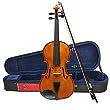Concert pitch = non-transposed pitch
String Instruments

Violin: treble clef, not transposing
Viola: alto clef, not transposing
Cello: bass, tenor and treble clef, not transposing
Double bass: bass clef, sounds 1 octave lower than written
Harp: grand staff, not transposing
Woodwind Instruments

Flute: treble clef, not transposing. Piccolo sounds 1 octave higher than written. Alto flute sounds a perfect 4th lower than written.
Oboe: treble clef, not transposing
Clarinet: treble clef. Clarinet Bb sounds a major 2nd lower than written, clarinet in A sounds a minor 3rd lower and clarinet in Eb sounds a minor 3rd higher. Bass clarinet in Bb sounds a compound major 2nd lower than written.
Bassoon: bass, tenor and treble clef, not transposing. Contrabassoon sounds an octave lower than written.
Cor anglais: treble clef, sounds a perfect 5th lower than written.
Brass Instruments

Trumpet: treble clef. Trumpet in Bb sounds a major 2nd lower than written. Trumpet in D sounds a major second higher than written. Trumpet in E is a major 3rd higher than written.
French Horn: treble clef. Horn in F sounds a perfect 5th lower than written. French horns exist in many keys – all tranpose down in to concert pitch (sounding), when written in treble clef. For example horn in G is a 4th lower (G is a 4th lower than C), and horn in C sounds an octave lower.
Trombone: bass and tenor clefs, not transposing.
Tuba: bass clef, not transposing
Percussion Instruments

Xylophone: treble clef, sounds 1 octave higher than written.
Glockenspiel: treble clef, sounds 2 octaves higher than written.
Timpani: bass clef, not transposing
Piano: grand staff, not transposing